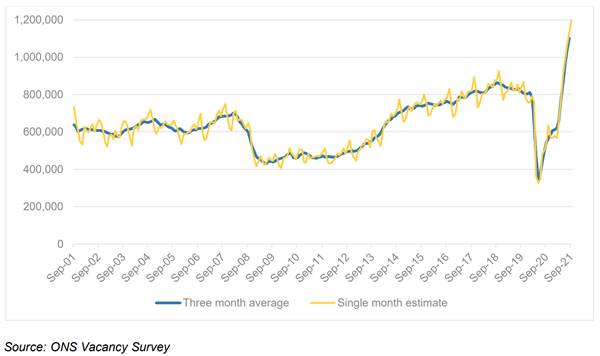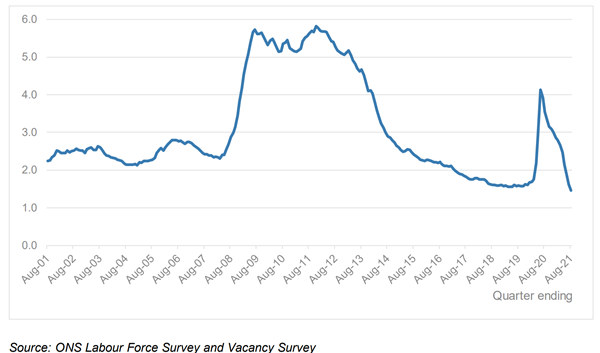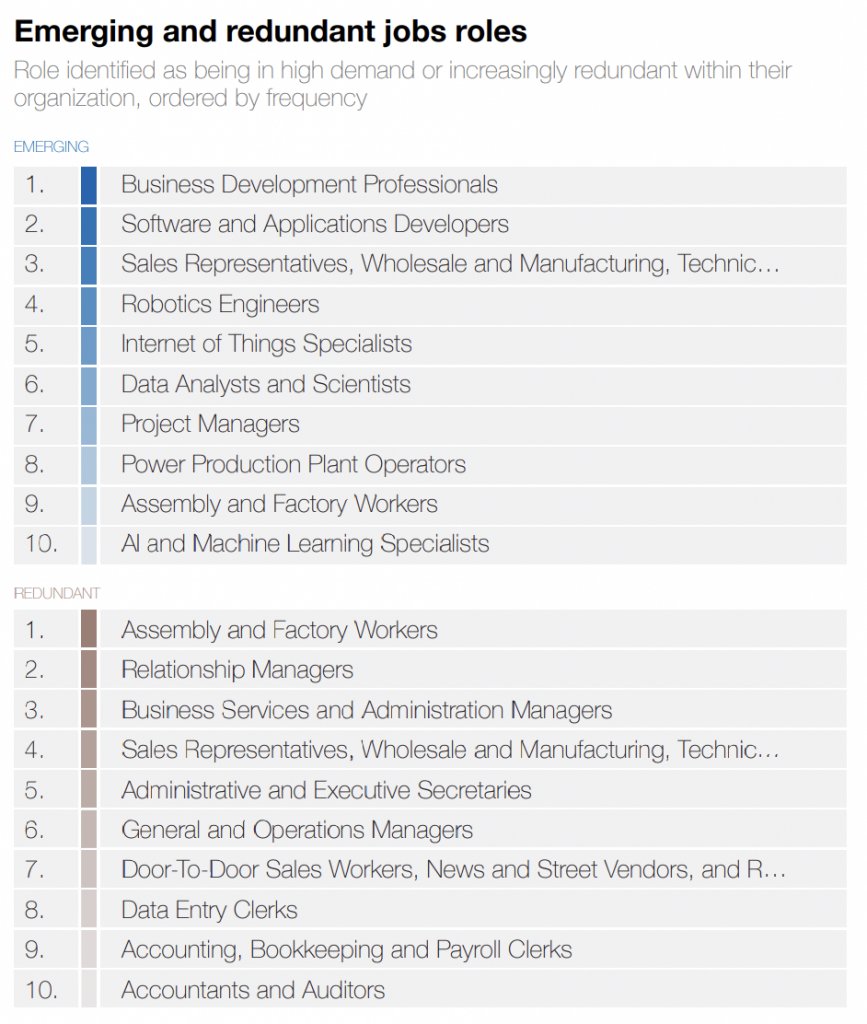Exploring the causes of the shrinking UK labour market – Dec 2021
The UK jobs market is currently experiencing sustained and significant structural change.
Overview
- The UK has recently lost 1.3 million workers since it left the EU
- Demand for viable workers has increased by 1.1 million
- Supply has fallen by 3.3 million.
- There are approximately 1.8m fewer 15-24-year-olds now in the labour market
- There are 200,000 55-60-year-olds also absent due to taking the option of early retirement in the wake of covid.
- 1.64m unemployed versus just 1.1m available advertised jobs.
- Record-high job vacancies and unemployment at 4.3%.
- 1.45 unemployed people per vacancy – the lowest figure in half a century and the tightest labour market in modern times
With mid-year figures showing 1.64m employed versus only 1.1m available advertised jobs, the future of the domestic jobs market looks increasingly uncertain. Speaking about the ‘Employment Arithmetic’ surrounding the issue, Martin-Fagg explains that “even if every unemployed person got a job, we are still short of around 2 million people”. The latest statistics from the ONS reveal this has only climbed higher in the past three months, with record-high job vacancies and unemployment at 4.3% nationally.

While we now have 1.45 unemployed people per vacancy – the lowest figure in at least half a century, making this likely the tightest labour market that we have seen in modern times.

What’s more, the effects of the pandemic appear to have only compounded the burden of Brexit. Despite some limited stabilisation following consecutive lockdowns, hiring in the manufacturing sector was still -4% its previous year-on-year average (in September 2020) and a “persistent hiring slump in Recreation and Travel, Consumer Goods and Manufacturing” jobs was among key findings in a recent study by the World Economic Forum.
These statistics, while concerning, are by no means isolated anomalies. Study after study confirms that the job market is struggling for breath in the wake of covid. For example, The Institute for Public Policy Research has underlined the “lopsided” market recovery as a crucial hurdle for the nation’s economy in a recent publication. It asserts that “there is still a huge jobs gap – jobs that have been hit by the pandemic have not returned.”
With the national birth also experiencing a steady decline, a “long-term economic stagnation” on the horizon is a clear cause for concern. In 2020, the total fertility rate (TFR) – i.e the number of children per woman – was at just 1.58 in England & Wales; well short of the 2.1 children needed to meet the critical replacement rate. As a result, according to a recent report by the Social Market Foundation, the UK could face worrying “long-term shortages of working-age adults” due to an acute “baby shortage”.

Coupled with a projected additional 7.5 million people aged 65 and over expected to make up the UK populace in just 50 years time, it is little wonder that working models need to change – and quickly.
“This combination of a lower share of the population in work and a higher share in need of economic support clearly has a negative effect on the productive capacity of the economy,” states the SMF.
Evidently, the connected complications of an ageing population and fewer children being born to replace lost workers is another stark reminder of the shrinking labour market and how companies will need to urgently adapt.
“The biggest constraint on growth is LABOUR. We are short of people, particularly as we’ve lost over a million EU workers… We are at full employment right now, so wage growth due to poaching will keep inflation up. ”
Roger Martin-Fagg, economist
An immediate imperative
How can employers counter the growing disparity between dwindling numbers of workers and record vacancies? The answer, quite simply, is in automation.
Manufacturing firms are struggling with a shortage of skilled workers. With the pandemic sharply shrinking the labour market, traditionally manual jobs are becoming increasingly obsolete – but process automation specialists, data analysts and scientists and AI and machine learning specialists are all named as among the top 10 developing job roles in a market becoming increasingly reliant on automation to maintain yield in the wake of huge losses to the workforce.

Is automation inevitable? With global and domestic trends becoming clear trajectories for a shrinking jobs market, it would certainly seem so.
References
- Jung, C. and Collins, F., 2021. FULL EMPLOYMENT AND GOOD JOBS FOR ALL WHY THE UK IS SEEING A LOPSIDED JOBS RECOVERY AND WHAT TO DO ABOUT IT. [online] Ippr.org. Available here
- Lucas, A., Romiti, M., Dennison, E. and Chiripanhura, B., 2021. Early insights of how the coronavirus (COVID-19) pandemic impacted the labour market – Office for National Statistics. [online] Ons.gov.uk. Available here.
- Office for National Statistics, 2021. Employment in the UK: July 2021. [online] Available here
- Office for National Statistics, 2021. Labour market overview, UK: November 2021. [online] Available here
- Office for National Statistics, 2021. Living longer: impact of working from home on older workers – Office for National Statistics. [online] Available here
- Office for National Statistics, 2021. Overview of the UK population: January 2021. [online] Available here
- Office for National Statistics, 2021. The probability of automation in England: 2011 and 2017. [online] Available here
- Social Market Foundation, 2021. “Baby shortage” could spell economic stagnation for UK – Social Market Foundation. [online] Available here
- Strausse, D., Financial Times, 2021. UK job vacancies hit record 1.1m as labour market tightens. [online] Ft.com. Available here
- SWMAS, 2021. Manufacturing Barometer nation report for Q2 2011/22. [online] Available here
- World Economic Forum, 2021. The Future of Jobs Report 2020. [online] Available here

